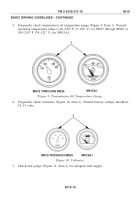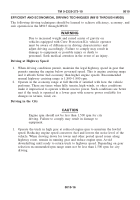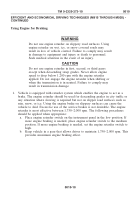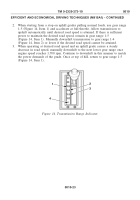TM-9-2320-273-10 - Page 184 of 452
EFFICIENT AND ECONOMICAL DRIVING TECHNIQUES (M915 THROUGH M920) -
CONTINUED
Using Engine for Braking
WARNING
Do not use engine retarder on slippery road surfaces. Using
engine retarder on wet, icy, or snow covered roads may
result in loss of vehicle control. Failure to comply may result
in damage to equipment and injury or death to personnel.
Seek medical attention in the event of an injury.
CAUTION
Do not use engine retarder in first, second, or third gears
except when descending steep grades. Never allow engine
speed to drop below 1,200 rpm with the engine retarder
applied. Do not engage the engine retarder when shifting or
when the transmission is in neutral. Failure to comply may
result in transmission damage.
1. Vehicle is equipped with retarder system which enables the engine to act as a
brake. The engine retarder should be used for descending grades in city traffic or
any situation where slowing is required but not on slipper road surfaces such as
rain, snow, or ice. Using the engine brake on slippery surfaces can cause the
vehicle to skid. Excessive use of the service brakes is not desirable. The engine
retarder is most effective between 1,750–2,000 rpm. The following procedures
should be applied when appropriate:
a. Place engine retarder switch on the instrument panel in the low position. If
more engine braking is needed, place engine retarder switch to the medium
position. If more engine braking is needed, set the engine retarder switch to
high.
b. Keep vehicle in a gear that allows driver to maintain 1,750–2,000 rpm. This
provides maximum engine braking effect.
TM 9-2320-273-10
0010
0010-18
Back to Top




















